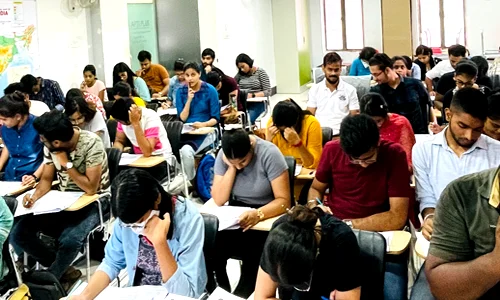



National Energy Conservation Day, observed on 14 December, underscores the importance of efficient and responsible energy use in India’s development journey. Through initiatives such as CCTS, PAT, UJALA, PM Surya Ghar, energy-efficient building codes, and behavioural programmes like LiFE, India is reducing energy wastage, strengthening energy security, and advancing its clean-energy and climate goals.
Click to View MoreThe Union Cabinet has approved a ₹7,280 crore scheme to set up India’s first integrated Rare Earth Permanent Magnet manufacturing facilities, targeting 6,000 MTPA capacity. It will reduce import dependence, support EVs and renewable energy, and contribute to Net Zero goals. The government also approved Pune Metro Phase 2 and two major railway infrastructure projects in Gujarat and Maharashtra.
Click to View MoreThe Global Energy Leaders’ Summit 2025 in Puri (Dec 5–7), hosted by Odisha and the Tony Blair Institute, focuses on “Powering India: Sufficiency, Balance, Innovation.” It supports India’s pillars of energy access, efficiency, sustainability, and security while advancing cooperation, clean energy transition, technology, and Net-Zero 2070 goals.
Click to View MoreIndia’s National Green Hydrogen Mission (NGHM) aims to position the country as a global leader in green hydrogen by 2030. Green hydrogen, produced using renewable energy, offers a clean alternative to fossil fuels, helping decarbonize hard-to-abate sectors like steel, fertilizers, mobility, and shipping. The Mission focuses on scaling production, promoting domestic manufacturing, fostering R&D through public-private partnerships, developing port-based hydrogen hubs, and implementing certification standards. Despite challenges like high costs, infrastructure gaps, and technology readiness, strategic policy support, financial incentives, and skill development are driving India’s transition toward a sustainable, low-carbon, and energy-secure future.
Click to View More
A recent scientific report warns that Earth is under severe climate distress, with 22 out of 34 key indicators reaching record highs. Rising global temperatures, greenhouse gas concentrations, ice melt, and extreme weather events signal that the planet is nearing critical tipping points. Despite growth in renewable energy, heavy reliance on fossil fuels continues, emphasizing the urgent need for rapid climate action to stabilize ecosystems and protect human and ecological well-being.
Click to View MoreIndia encourages hybrid solar-wind-storage systems to ensure a steady clean energy supply, backed by government policies, despite challenges like high costs and land shortages. To achieve sustainable energy goals and become a global leader, India needs to focus on advanced storage solutions, smart grid development, and adaptable regulations.
Click to View MoreIndia is developing a Climate Finance Taxonomy to guide sustainable investments and bridge a $170 billion annual climate finance gap by 2030. A CSEP report emphasizes that the taxonomy must be practical, inclusive, and aligned with domestic priorities while remaining credible to global investors. Key recommendations include supporting MSMEs, integrating adaptation finance, promoting indigenous innovations, and ensuring coordination between RBI, SEBI, and the Ministry of Finance. The framework should be dynamic, evolving with technology and market needs to effectively channel finance toward India’s real climate goals.
Click to View MoreIndia’s first National Policy on Geothermal Energy, led by MNRE, marks a major step toward Net Zero 2070. It promotes 24/7 clean power through fiscal incentives, repurposed oil wells, and joint ventures to develop 10 geothermal provinces, strengthening India’s sustainable energy transition.
Click to View MoreThe International Solar Alliance, launched by India and France at COP21, unites over 120 nations to drive a global solar revolution. Aiming to mobilize $1 trillion by 2030, it promotes clean energy access through initiatives like OSOWOG, fostering sustainability, energy security, and climate resilience.
Click to View MoreIndia aims for 500 GW renewable capacity by 2030 and net-zero by 2070, relying on critical minerals like lithium and cobalt. To reduce import dependence, it launched the National Critical Minerals Mission, promoting domestic mining, recycling, circular economy, and public-private partnerships for energy self-reliance.
Click to View MoreIndia’s carbon credit market, guided by the Carbon Credit Trading Scheme (CCTS) 2023, aims to accelerate the country’s transition toward a low-carbon economy and meet its Net Zero 2070 goal. The market allows entities to trade verified emission reductions through renewable energy, afforestation, and sustainable farming projects. However, challenges such as weak verification systems, limited domestic demand, inequitable benefit-sharing, and risks of land displacement persist. Strengthening monitoring, reporting, and verification (MRV), ensuring community participation, and improving regulatory transparency are essential for building a fair, credible, and effective carbon market that supports inclusive climate action.
Click to View MoreThe IEA’s Renewables 2025 report highlights rapid global energy transition, with Solar PV driving growth. India to become the second-largest market, but addressing grid bottlenecks, transmission expansion, and DISCOMs’ financial fragility is crucial to sustain progress and meet COP28 goals.
Click to View More
© 2025 iasgyan. All right reserved